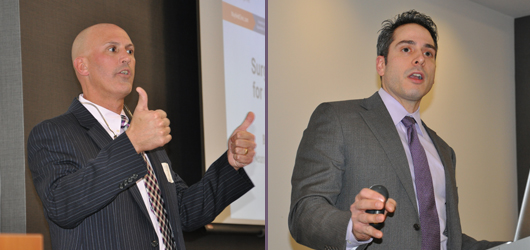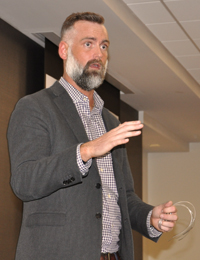
Spinal cord stimulators are unlikely to eliminate pain completely, but they can bring most individuals back into the happy fold of daily activities.
That was the message delivered by Mayfield Clinic specialists Marc Orlando, MD, and Brad Curt, MD, and a spokesman for Boston Scientific last week at the seminar, “Therapy Options for Managing Your Chronic Pain,” at Mayfield’s new Rookwood Exchange location.
“I expect a pain reduction of 50 to 70 percent,” said Dr. Orlando, a physical medicine and rehabilitation specialist who has recommended spinal cord stimulators to more than 2,000 patients during his career. “We are not going to get you to 100 percent.”

That point was eloquently made by Justin Minyard, a former U.S. Army sergeant and Boston Scientific spokesman who suffered complex back injuries as a first responder after 9/11 and during a deployment to Afghanistan. “I’m in pain right now,” he told the packed room. “I’m around a 2.”
On the pain scale of 1 to 10, where a 10 means “you’re hurting so much you’re ready to cut your arm off,” in Dr. Orlando’s words, a 2 is definitely a livable situation.
Even a 6 might represent a return to function. “If I helped you go from an 8 to a 6 and made it livable,” Dr. Orlando added, “I’m happy.”
A spinal cord stimulator is a device that is surgically implanted under the skin and delivers a mild electric current to the spinal cord. The current interrupts pain signals to the brain from the back, neck or extremities while generating a mild tingling sensation.
Patients are candidates for a stimulator if:
• they experience chronic pain, defined as pain that lasts longer than 6 months
• they have pain that physical therapy and surgery cannot correct
• they have undergone surgery to correct a structural problem, such as spinal stenosis or scoliosis, but are still experiencing pain
• their quality of life is being compromised by pain medications
Sgt. Minyard’s injuries included fractured vertebrae and ruptured disks. He underwent a 5-level fusion, emerging with a 7-inch rod in his back. The corrective surgery repaired his spine, but it did not eliminate his pain. After spending two years in a painkiller-induced fog and surviving two accidental overdoses and one purposeful overdose, Sgt. Minyard knew he needed a change. “I had to find someone whose only job it is to help people escape their pain,” he said.
He scheduled an appointment to undergo a spinal cord stimulator “trial,” which was performed to determine whether a stimulator would curb his pain.
During a stimulator trial, a physiatrist (like Dr. Orlando) inserts a hollow-tube needle into the epidural space between the bony vertebra and the spinal cord.
“I then advance an 8- to 16-electrode wire – the wire is the size of the lead in a Number 2 pencil — into the epidural space,” Dr. Orlando explained. “A representative from the stimulator company turns on the electrical signal or impulse from the battery pack to stimulate the spinal cord and block the body’s perceived pain signals from going to the brain.”
Over the next few days, the patient experiences the stimulator and keeps a diary, detailing how much it helps during specific activities. If the trial proves successful, a neurosurgeon then implants the lead in the epidural space and the pulse generator in the buttock or abdomen.
“We make a small hole in the bone,” Dr. Curt explained. “Once the opening is big enough, we slide the paddle electrode on top of the covering of your spinal cord. We slide this over the spine so that electricity can make contact with the spinal cord. We’re mimicking the location where the trial determined it should be. Then we wake you up.
“We ask whether you feel it, whether we are covering your pain. If we’re lucky and you are happy, we put you back to sleep and tunnel all the wires up to the battery pack. If we’re not lucky, we reposition and re-test until we get it right. The nice thing is, you try it out just as you would a car you test-drive for the weekend. Then you go to the recovery room. And an hour later, you go home.”
The downside of the spinal cord stimulator, Dr. Curt said, is that it does not work for everybody. “I caution people, if the trial doesn’t work, then the stimulator won’t work. We don’t want to just give you a scar and a bill. We have a lot of tools to treat pain, and no individual is the same.”
Other strategies include:
• pain pumps, which deliver pain medicine internally, via a catheter; they are especially helpful for patients who experience wide-ranging bone pain
• over-the-counter medications
• anti-seizure medications, even if the patient does not experience seizures (e.g., Nerontin, Gabapentin)
• anti-depressants, even if the patient does not experience depression (e.g., Noxepin, Nortriptyline)
For Sgt. Minyard, the stimulator did the trick. He has 16 different programs on his device, including one for spending eight hours on his feet at Disneyworld with his daughter. “It truly has given me my life back,” he said. “I haven’t taken any narcotics in five and a half years.”
— Cindy Starr